Ignatius Sancho- A man of letters
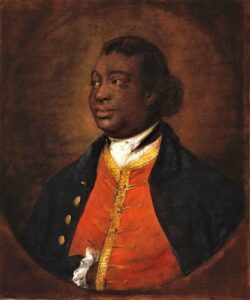 This Black History Month we turn our attention to one of the borough’s less well known public figures, Ignatius Sancho, and with help from our Local Studies Library and Archive here’s what we uncovered.
This Black History Month we turn our attention to one of the borough’s less well known public figures, Ignatius Sancho, and with help from our Local Studies Library and Archive here’s what we uncovered.
Early life
(Charles) Ignatius Sancho was born in about 1729 on a ship carrying slaves from Africa to the West Indies, his parents died shortly after his birth. He was brought to England aged two and given to three sisters who raised him. Living in Greenwich he met John, second duke of Montagu, who lived in nearby Blackheath. Impressed by his intelligence the duke gave him an education and employment.
Living in Richmond upon Thames
He spent time at the Montagu residence in Richmond upon Thames around 1749-1751 and again from 1766-1774 after the duke’s death. He was employed by the duke’s widow as a butler, a very responsible position in a noble household. After the duchess died Sancho tried to become an actor, with limited success.
His intellect, education and access to the Montagu’s library gave rise to a respected man of letters.
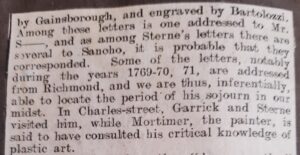
He wrote to many people, including Richmond residents, George Brudnell, first duke of Richmond, the duke of Queensbury and Horace Walpole.
The famous Thomas Gainsborough portrait of Sancho was painted in 1768 in Bristol. Gainsborough had connections with Richmond upon Thames too, he lived for a time on Richmond Hill and he is buried in St Anne’s Church in Kew.
Sancho’s letters covered a range of subjects, including art, theatre and literature. He also composed minuets, songs and dances, with titles including ‘Kew Gardens’ ‘La loge de Richmond’ and ‘Bushy Park’.
Richmond October 20 1769
I sent you a note in Mrs Sanchos name this day fortnight importing that she wold hope for the pleasure of seeing you at Richmond before the fine weather takes leave of us…
…Tell your coachman to drive under the hill to Mr B’s on the common, where you will be gladly received by the best half of your much and greatly obliged friend-Ignatius Sancho
Several of the letters most likely to Laurence Sterne, were addressed from Richmond. They were most likely written when Sancho worked in the Montagu household, possibly from (no longer existing) Montague House, also known as Buccleuch House. In one letter Sancho asks him to consider the subject of slavery in one of his novels.
July 21 1766
Reverend Sir-
Consider slavery – what it is – how bitter a draught – and how many millions are made to drink it! – Of all my favourite authors, not one has drawn a tear in favour of my miserable black brethren – excepting yourself, and the humane author Sir George Ellison. – I think you will forgive me; – I am sure you will applaud me for beseeching you to give one half hour’s attention to slavery, as it is at this day practiced in our West Indies. – That subject, handled in your striking manner, would ease the yoke (perhaps) of many – but it only of one – Gracious God! – what a feast to a benevolent heart! – and, sure I am, you are an epicurean in acts of charity. – You, who are universally read, and as universally admired – you could not fail – Dear Sir, think in me you behold the uplifted hands of thousands of my brother Moors. Grief (you pathetically observe) is eloquent; – figure to yourself their attitudes; – hear their supplicating addresses! – alas! – you cannot refuse. Humanity must comply.
In 1758 he married Anne Osbourne and went on to have 7 children, four whom survived to adulthood. The Richmond parish register records the death of one of his children. We also found a record of his presence as a witness at a marriage.
Burial 1769 March 28th John Sancho a child
Marriages 1758 July 13th Francis Williams of St Andrews Holborn and Ann Moore of Richmond: banns. Witnesses Ignatius Sancho, Andrew Moore.
Life after Richmond upon Thames
Illness rendered Sancho unfit to continue working in the Montagu house. He established a grocery store at 20 Charles Street, Westminster. His financial independence as a male householder qualified him to vote. He become the first known person of African heritage to have voted in parliamentary elections in 1774 and 1780.
Sancho continued to be a prolific letter writer until his death in 1780 where upon he was the first African to be given an obituary in the British press. He gained widespread celebrity when his letters were published posthumously. His widow, Anne, received over £500 from the more than 1200 subscribers to his Letters.
Recent recognition
A couple of weeks ago I was lucky enough to attend the book launch of The Secret Diaries of Charles Ignatius Sancho, a debut novel written by Paterson Joseph (of The Peep Show and Casualty fame), published by Dialogue Books.
Not only is Sancho’s story intriguing, the author’s connection with his subject is just as fascinating. Paterson Joseph first encountered Ignatius Sancho on the pages of Black England by Gretchen Gerzina. He became intrigued by this figure of a black actor he’d never heard of. In response Paterson Joseph wrote, Sancho: The Act of Remembrance, and he even performed in it at the Orange Tree Theatre in 2019. As Joseph’s obsession with the character grew, he found himself writing a fictionalised story of Sancho’s life, in the manner of eighteenth-century literary masters. His aim was to portray a black man living his ordinary life in Britain in a similar way in which Dickensian characters are written.
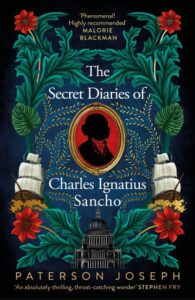 We know about Sancho’s life from his letters, published posthumously, but Joseph’s book is written as a fictional diary in which Sancho writes about his life to his son, Billy. It touches on his encounters with celebrities and royalty, but largely concentrates on his personal history, his growing family and his beloved wife. We get a glimpse of a rich life, domestic yet well lived, although the author does not shy away from the matters of anti-slavery and painful issues.
We know about Sancho’s life from his letters, published posthumously, but Joseph’s book is written as a fictional diary in which Sancho writes about his life to his son, Billy. It touches on his encounters with celebrities and royalty, but largely concentrates on his personal history, his growing family and his beloved wife. We get a glimpse of a rich life, domestic yet well lived, although the author does not shy away from the matters of anti-slavery and painful issues.
This is a story where comedy meets tragedy, where characters jump out from pages and invite the readers to follow their adventures. The book that introduces the reader to a real, fleshed out, captivating character. It is not a story of endurance and tragedy, but the story of an ordinary person we want to learn more about. The mix of humour and seriousness makes it a very readable story.
I would give thee Books
You’ll find Garfield Road park just steps from Twickenham Library, a pocket of green away from the busy Twickenham shopping streets and station. In the past few months benches have appeared with quotes from writers and authors who have connections to the borough. What quote could be more fitting than the one from Ignatius Sancho?
Were I as rich in worldly commodity,
as in hearty will… I would give thee Books
Ignatius Sancho

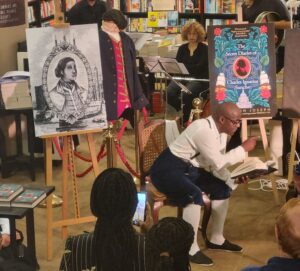
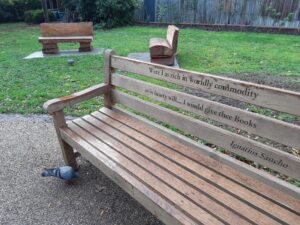
Leave a Reply